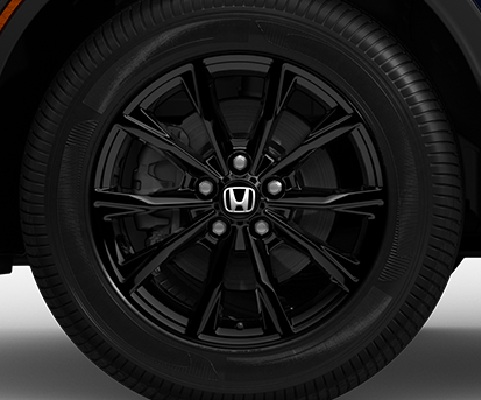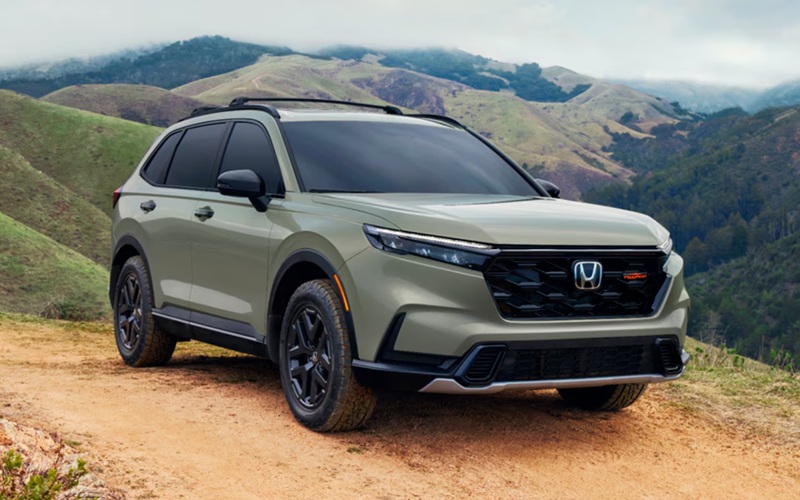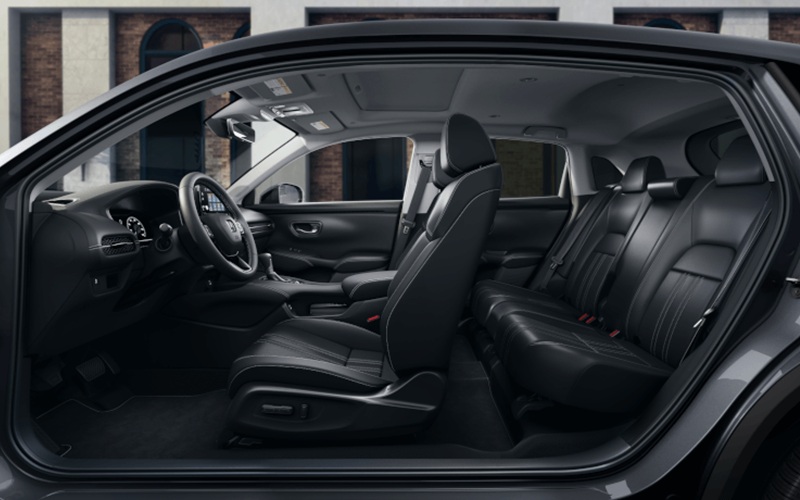The Honda CR-V has established itself as one of the most popular compact SUVs on the market, thanks to its six generations of production. Whether you’re looking to replace factory wheels, upgrade to aftermarket options, or prepare for seasonal tire changes, understanding the rim specifications for your specific CR-V model is essential.

CR-V Wheel Specifications: Generation by Generation
The Honda CR-V has evolved significantly since its introduction, with each generation featuring different wheel specifications to match its design and performance characteristics.
First Generation (1997-2001)
The original CR-V established the platform’s reputation for reliability and practicality. These models came equipped with:
- Standard rim size: 15 x 6 inches
- Bolt pattern: 5×114.3mm (also referred to as 5×4.5 inches)
- Center bore: 64.1mm
- Offset: 45mm
- Common tire size: 205/70R15
These relatively modest wheel dimensions suited the first-generation utilitarian character and helped deliver its comfortable ride quality and decent off-road capability.
Second Generation (2002-2006)
With the second generation, Honda began offering multiple wheel options depending on trim level:
- Standard rim sizes:
- LX trim: 16 x 6.5 inches
- EX trim: 16 x 6.5 inches
- Bolt pattern: 5×114.3mm
- Center bore: 64.1mm
- Offset: 45mm
- Common tire sizes: 215/65R16, 215/60R16
This generation maintained the same bolt pattern while increasing wheel diameter and width slightly to accommodate the vehicle’s growth and evolving design language.
Third Generation (2007-2011)
The third-generation CR-V saw further refinement and additional wheel options:
- Standard rim sizes:
- LX trim: 17 x 6.5 inches
- EX trim: 17 x 6.5 inches
- EX-L trim: 17 x 6.5 inches
- Bolt pattern: 5×114.3mm
- Center bore: 64.1mm
- Offset: 45mm
- Common tire size: 225/65R17
This generation standardized 17-inch wheels across most trim levels, improving handling characteristics while maintaining ride comfort.
Fourth Generation (2012-2016)
The fourth-generation CR-V further refined the platform with:
- Standard rim sizes:
- LX trim: 16 x 6.5 inches
- EX and above trims: 17 x 6.5 inches
- Touring trim: 18 x 7 inches (introduced in 2015)
- Bolt pattern: 5×114.3mm
- Center bore: 64.1mm
- Offset: 45mm
- Common tire sizes: 215/70R16, 225/65R17, 225/60R18
This generation introduced 18-inch wheels to the CR-V lineup on higher trim levels, establishing a pattern of wheel size differentiation based on trim that continues today.
Fifth Generation (2017-2022)
The fifth-generation CR-V offered the most diverse wheel lineup to date:
- Standard rim sizes:
- LX trim: 17 x 7.5 inches
- EX/EX-L trims: 18 x 7.5 inches
- Touring/Black Edition trims: 19 x 7.5 inches
- Bolt pattern: 5×114.3mm
- Center bore: 64.1mm
- Offset: 45mm
- Common tire sizes: 235/65R17, 235/60R18, 235/55R19
This generation standardized wider wheels across all trims and introduced 19-inch options for the first time, emphasizing the model’s increasingly premium positioning.
Sixth Generation (2023-Present)
The current generation of the CR-V features the largest wheels in the model’s history:
- Standard rim sizes:
- LX/Sport trims: 17 x 7.5 inches
- EX-L trim: 18 x 7.5 inches
- Touring/Sport Touring trims: 19 x 7.5 inches
- Bolt pattern: 5×114.3mm
- Center bore: 64.1mm
- Offset: 45mm
- Common tire sizes: 235/65R17, 235/60R18, 235/55R19
Notably, the new Hybrid models (including the Sport and Sport Touring trims) continue this same wheel and tire specification trend.
Wheel Specifications
To make informed decisions about potential wheel changes or upgrades, CR-V owners should understand several key specifications:
Bolt Pattern
Perhaps the most critical wheel specification, the bolt pattern determines which wheels can physically attach to your vehicle. The CR-V has maintained the same 5×114.3mm pattern across all generations, which is expressed as:
- Number of bolt holes: 5
- Diameter of the circle formed by the bolts: 114.3mm
This consistent bolt pattern is the same as with many Honda and Acura models, as well as vehicles from other manufacturers, making aftermarket and cross-compatible options widely available.
Center Bore
The center bore is the hole in the middle of the wheel that centers it on the vehicle’s hub. The 64.1mm center bore has remained constant throughout all generations. When selecting aftermarket wheels, those with a larger center bore can be made compatible using hub-centric rings, which are inexpensive adapters that fill the gap between the wheel and hub.
Wheel Offset
Offset measures the distance between the wheel’s mounting surface and the centerline of the wheel. The CR-V typical 45mm offset is a “positive” offset, meaning the mounting surface is toward the outside face of the wheel. This specification influences:
- Clearance between the tire and suspension components
- Handling characteristics and stability
- Overall track width and appearance
Deviating significantly from the factory offset can cause issues with fitment, handling, and component wear.
Load Rating
Each CR-V wheel has a specific load rating indicating the maximum weight it can support. This rating is particularly important to consider when selecting replacement wheels, especially for vehicles that frequently carry heavy loads or tow trailers.
Considerations for Wheel Changes and Upgrades
CR-V owners contemplating wheel changes should keep several factors in mind:
Tire Pressure Monitoring System (TPMS)
All CR-V models from 2008 onward have TPMS, which uses sensors mounted inside each wheel to monitor tire pressure. When changing wheels, these sensors must either be:
- Transferred to the new wheels
- Replaced with new compatible sensors
- Bypassed with specialized TPMS simulator tools (not recommended for safety reasons)
Without properly functioning TPMS sensors, the vehicle will display a warning light on the dashboard.
Winter Wheel Considerations
Many CR-V owners opt for dedicated winter wheels and tires. When selecting winter wheel packages, consider:
- Downsizing one inch in diameter to allow for taller tire sidewalls, improving winter performance
- Narrower wheels and tires to enhance snow traction
- Simpler wheel designs that resist salt and slush buildup
- Alloy wheels with protective finishes or steel wheels to resist winter corrosion
For example, a CR-V Touring with 19-inch factory wheels might perform better in winter with 18-inch or even 17-inch winter wheels fitted with appropriate winter tires.
Lug Nuts and Torque Specifications
The CR-V uses specific lug nuts that match the factory wheels’ tapered seat design. When changing to aftermarket wheels, different lug nuts may be required depending on the wheel’s seat type. Always torque lug nuts to the factory specification of 108 Nm (80 lb-ft) using a calibrated torque wrench and the proper tightening sequence (crisscross pattern).
Compatible Wheel Options and Considerations
OEM Wheel Interchangeability
One advantage of the consistent wheel specifications is compatibility with wheels from other Honda and Acura models. Some examples of OEM wheels that typically fit the CR-V include those from:
- Honda Accord (most generations from 2003 onward)
- Honda Civic (selected larger wheel options from 2006 onward)
- Acura RDX (first and second generations)
- Acura TSX (all generations)
- Honda Element (all years)
Always verify specific wheel dimensions before purchasing, as offset and width variations can affect fitment even when the bolt pattern is compatible.
Aftermarket Options
The aftermarket offers countless wheel options compatible with the CR-V specifications. When exploring these options, consider:
Size Limitations
While the CR-V can accommodate various wheel sizes, there are practical limits to consider:
- Minimum recommended diameter: 16 inches (to clear brake components)
- Maximum practical diameter: 20 inches (though clearance and ride quality become concerns)
- Width range: 6.5 to 8.5 inches (depending on desired tire profile and offset)
Finish Durability
The CR-V is often used in challenging conditions, so wheel finish durability matters:
- Painted finishes: Attractive but susceptible to curb damage
- Diamond-cut/machined finishes: Popular but can oxidize if the clear coat is damaged
- Powder-coated finishes: Generally more durable than wet paint
- Chrome: High maintenance but resistant to salt and corrosion
Weight Considerations
Wheel weight affects both performance and efficiency:
- Lighter wheels improve acceleration, braking, and fuel economy
- Cast wheels (most common) balance cost and weight
- Flow-formed/rotary-forged wheels offer reduced weight at moderate cost
- Fully forged wheels provide maximum strength and minimum weight at premium prices
Special Considerations for Hybrid CR-V Models
The CR-V Hybrid models share the same wheel specifications as their conventional counterparts, but their increased weight and regenerative braking system create some unique considerations:
- Load rating: Ensure any replacement wheels meet or exceed the load rating of the original wheels, as hybrid models are typically 100-150 kg heavier than their non-hybrid equivalents.
- Wheel design: The aerodynamic efficiency of wheel designs can significantly impact the hybrid’s fuel economy, more so than with conventional models.
- Brake dust: The regenerative braking system often results in less brake dust accumulation, potentially keeping wheels cleaner between washes.
Proper Wheel Maintenance
To maximize the lifespan and appearance of CR-V wheels:
- Regular cleaning: Clean wheels every 2-4 weeks using pH-neutral wheel cleaners specifically designed for your wheel’s finish.
- Seasonal protection: Apply wheel sealant or wax at the beginning of each season to protect against environmental contaminants and brake dust.
- Torque verification: Check lug nut torque periodically, especially after wheel installation or removal.
- Rotation adherence: Follow the recommended Honda rotation pattern and intervals (typically every 10,000 km).
- Prompt repairs: Address curb damage promptly to prevent corrosion from developing, especially on alloy wheels.
By understanding the specifications, options, and maintenance requirements for CR-V wheels, owners can make informed decisions that strike a balance between aesthetics, performance, and practicality. Whether sticking with OEM equipment or exploring aftermarket options, the consistent specifications provide flexibility while maintaining the vehicle’s renowned reliability and performance.
Questions and Answers
Can I use wheels from other Honda models on my CR-V?
- Yes, many Honda and Acura models share the 5×114.3mm bolt pattern and similar specifications. Wheels from vehicles like the Accord, Civic (2006+), Element, Acura RDX, and TSX can often fit. However, you should always verify that the center bore (64.1mm), offset (around 45mm), and load rating are compatible with your specific model to ensure proper fitment and safe operation.
What size winter wheels should I use for my CR-V Touring with 19-inch factory wheels?
- For winter driving, downsizing to 18-inch or 17-inch wheels is recommended. This allows for taller tire sidewalls, which improve winter performance by providing better impact absorption over rough, frozen surfaces. When downsizing, ensure the total diameter (wheel + tire) remains within 3% of the original size to maintain proper speedometer calibration and clearance. For most Touring models, 17×7 wheels with 235/65R17 winter tires provide excellent winter performance while maintaining proper specifications.
How do I know what the correct torque specification is for my CR-V lug nuts?
- The factory torque specification for lug nuts is 108 Nm (80 lb-ft) across all generations. You can find this information in your owner’s manual. Always use a calibrated torque wrench and tighten in a star or crisscross pattern to ensure even clamping force. Re-torque the lug nuts after driving approximately 50-100 km following any wheel installation to account for initial settling.
Will changing to larger aftermarket wheels affect my CR-V fuel economy and performance?
- Yes, changing wheel and tire sizes can impact fuel economy and performance. Generally, larger and heavier wheels increase unsprung weight, which can reduce acceleration and fuel efficiency while potentially improving handling up to a point. For each inch you increase in wheel diameter, you can expect a reduction in fuel economy of approximately 1-3%, depending on the weight difference. Hybrid models may be more sensitive to these changes due to their focus on efficiency. To minimize the impact, consider lightweight wheel designs when upgrading to larger sizes.
Do I need to reprogram my CR-V TPMS system when installing new wheels?
- When installing new wheels on a vehicle (2008 or newer), you’ll need to address the Tire Pressure Monitoring System (TPMS). When transferring the original sensors to new wheels, typically no reprogramming is needed, as the sensors maintain their unique ID. However, if installing new TPMS sensors, a dealer or properly equipped service center will need to register these sensors to your vehicle using specialized equipment. Most models use an “auto-learning” feature that can register new sensor IDs after a specific driving procedure, but this varies by model year. Refer to your vehicle’s owner’s manual for the specific procedure for your vehicle.




